|
|
|
Sort Order |
|
|
|
Items / Page
|
|
|
|
|
|
|
| Srl | Item |
| 1 |
ID:
167810
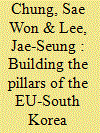

|
|
|
|
|
| Summary/Abstract |
This paper explores the evolution of the policy agenda of the EU-South Korea strategic partnership, based on key pillars of cooperation: politics, security, and economics. In the political arena, the Framework Agreement has provided a major platform for promoting EU-Korea political dialogue and developing a common stance toward a shared global agenda. When it comes to security, the main agenda involves North Korea’s missiles, nuclear program, and the challenge of nonproliferation; the two parties have coordinated sanctions against North Korea. South Korea has enacted a Crisis Management Participation Agreement (FPA) with the EU and begun to participate in the EU common security and defence policy. The changing security environment on the Korean Peninsula, as a consequence of recent inter-Korean and US-North Korea dialogues, may offer the EU new opportunities for constructive engagement. In the economic arena, the EU-Korea FTA has established solid trade and investment relations. While these pillars of the strategic partnership have led to stable and mature bilateral relations, both the EU and South Korea need to find new momentum for an enhanced partnership to deal with the ongoing challenge of global security instability and the backlash against the liberal international order. The EU-South Korea strategic partnership also needs a global agenda that covers climate change, technology, education, and culture. This study assesses the development of each pillar of the strategic partnership, addressing key challenges, tasks, and future diplomatic developments between the EU and South Korea.
|
|
|
|
|
|
|
|
|
|
|
|
|
|
|
|
| 2 |
ID:
167806


|
|
|
|
|
| Summary/Abstract |
Faced with the emergence of strategic partnerships (SP), international actors have approached this new phenomenon in the international system through different logics of action. Such logics are tightly associated with the purposes that the SPs are intended to fulfill for the initiating actor. They also tend to reflect the worldview of the initiators as well as their perceptions of the major organizing principles of the international system. In this article, we investigate three different logics: the conventional, the relational, and the functional. These three logics correspond to the strategies of strategic partnering of the United States (US), China, and the European Union (EU) and reflect both the dominant foreign policy orientation of these actors and their self-perceptions as major poles of power in the world. We analyze the construction of these logics by focusing on the relative importance that each of them accords to interests and values when setting up SPs around the world. We contend that an important conceptual gap exists between the major initiators of strategic partnerships, the US and China, which are both to a large extent driven by a self-perception as Great Powers, although the logics with which they seek to fulfill this role diverge substantially. The EU pursues SPs according to a functional logic which in itself also diverge in significant aspects to both the US and China. Taken together, the interests which dictate the necessity of strategic partnerships and the values which condition their feasibility form four distinct patterns of partnering: the homogenous, marriage-of-convenience, come-in-handy, and heterogeneous SPs. These ideal forms of SPs have distinct but contrasting implications for the structure of the international system.
|
|
|
|
|
|
|
|
|
|
|
|
|
|
|
|
| 3 |
ID:
167811
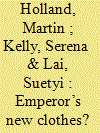

|
|
|
|
|
| Summary/Abstract |
In order to adapt to a changing global order, the European Union (EU) has established an important mechanism for cooperating with some of the world’s most influential countries—strategic partnerships (Renard 2012). Four of these partners are Asian—China, India, Japan and South Korea. As a mechanism for understanding the importance of the EU’s strategic partnership agreements in Asia as well as the EU’s potential influence in these countries, this paper examines and compares how the EU’s four strategic partners in Asia view the Union. It identifies similarities and differences in their perceptions of, and attitudes towards, the EU. The paper draws on a methodologically robust data analysis examining three fields of interest in these four countries over 10 years: (1) the filters through which the EU is reported on and understood by the news media in the respective countries; (2) how the EU is perceived by the general public; (3) how the EU is perceived and understood by the national elites in its four strategic partners in Asia. The article demonstrates some similarities and differences across the four strategic partnerships. Firstly, and positively for the EU, the EU’s strategic partnerships in the four Asian countries are viewed as being more than just about a trading relationship for the countries involved. Secondly, these partnerships have been regarded as comprehensive. Thirdly, there was also a noticeable image of an increasingly inwardly occupied EU from 2006 to 2015, hence potentially diminishing the perceived global actorness of the Union. Fourthly, the studied Asian countries considered the EU one of their important partners but ranked it behind the USA and their neighbouring countries. Finally, positive impressions of the EU were also found to have weakened considerably in the past decade.
|
|
|
|
|
|
|
|
|
|
|
|
|
|
|
|
| 4 |
ID:
167805
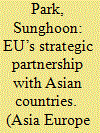

|
|
|
|
|
| Summary/Abstract |
The European Union has struggled for a long time to increase the international profile of its foreign policy. The intensity of the EU’s foreign policy has been a function of the speed and efficacy of its own internal integration programs. For instance, the Single European Market (SEM) program pursued during the period of 1986–1992 took a substantial amount of time and resources of the EU policy makers, thereby leading to a temporary vacuum of EU’s foreign policy especially vis-à-vis countries geopolitically remote to the EU, including the Asian region. The adoption in 1994 of the New Asia Strategy (NAS) was a welcomed move by the EU to reinvigorate its relationship with Asian countries that had been showing an increasing strategic value since the mid-1980s. The USA also adopted an aggressive Asia Strategy under the name of Big Emerging Markets (BEMs) strategy around the same time, through which the US administration designated 17 big emerging markets as priority economic (and political) cooperation partners. In fact, 12 of 17 BEMs were Asian countries, which signaled that Asia was rediscovered and the USA and the EU started competing for a strategic leverage in the Asian region.
|
|
|
|
|
|
|
|
|
|
|
|
|
|
|
|
| 5 |
ID:
167807
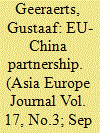

|
|
|
|
|
| Summary/Abstract |
The EU-China relationship is driven by two distinct underlying logics: a power-based one and a transformational one. The power-based logic is premised on a belief that because of anarchy, power politics and conflicts of interest cannot be entirely overcome. According to this view, intercourse between the EU and China will reflect their relative power positions and display concerns about relative gains, making cooperation between them more difficult. In contrast, a transformational logic reflects a more liberal/constructivist perspective. It suggests that rules and shared norms can sharply reduce conflicts of interest and mitigate concerns about relative gains through the creation of trust and reciprocal socialization, making enduring cooperation between the EU and China more likely. The EU-China relationship is thus clearly mixed, consisting of an array of cooperative and competitive elements. At any given moment, the relationship can be pictured as residing somewhere along a spectrum that extends from pure cooperation at one extreme to unrestrained competition at the other. Diverging trends, which are mutually reinforcing, are pushing the relationship toward competition, converging trends—also reinforcing each other—are promoting cooperation. The direction in which the EU-China partnership can possibly evolve—more competition or more cooperation—will be moulded by the relative strength of diverging and converging trends.
|
|
|
|
|
|
|
|
|
|
|
|
|
|
|
|
| 6 |
ID:
167809
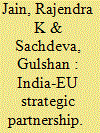

|
|
|
|
|
| Summary/Abstract |
This article examines the role of strategic partnerships in Indian foreign policy and the nature and perceptions of India and the European Union about the strategic partnership. It discusses how both sides look at global governance, normative divergence, and security cooperation. It assesses Prime Minister Narendra Modi’s perceptions and engagement with Europe since coming to power in 2014. It analyses the economic dynamics of the partnership and assesses the reasons for the impasse in the conclusion of a Broad-based Investment and Trade Agreement. It discusses the salient features of EU’s India Strategy (2018). In conclusion, the article argues that in a more volatile world, India is re-engaging Europe with greater vigour and that both sides seek to build and consolidate the strategic partnership on commonalities.
|
|
|
|
|
|
|
|
|
|
|
|
|
|
|
|
| 7 |
ID:
167808


|
|
|
|
|
| Summary/Abstract |
Japan and the EU formally agreed on the outline of The Japan-EU Strategic Partnership Agreement (SPA) and the Economic Partnership Agreement (EPA) on 7 July 2017 and finalized on 17 July 2018. Despite such major shifts in the relationship between Japan and Europe, it is unfortunately true that Japanese society does not have a high level of interest in establishing a cooperative relationship or negotiating agreements such as the SPA with the EU, in fields other than economics. However, this low level of interest does not mean that strengthening a political relationship with the EU is unimportant. Rather, confirming that Japan and the EU share the basic values promoted by the SPA is even more important now than it was in 2011, when both leaders decided to initiate SPA and EPA negotiations. The international order—based on values such as liberty, democracy, the rule of law, human rights, the market economy, and free trade—which has been built up by Western countries, including Japan, since the end of the Second World War, is being challenged not only by emerging countries such as China but also by the Trump Administration in the United States. Japan-Europe relations after World War II have historically been dominated by economic friction, especially in the 1960s–1980s. But the experiences involved in resolving the economic friction enabled the relations to evolve from economic interests to the other area. There was a qualitative transformation of the relationship between Japan and Europe in the 1990s. This paper assesses the importance of cooperation with the EU for Japan in the twenty-first century.
|
|
|
|
|
|
|
|
|
|
|
|
|
|
|
|
|
|
|
|
|